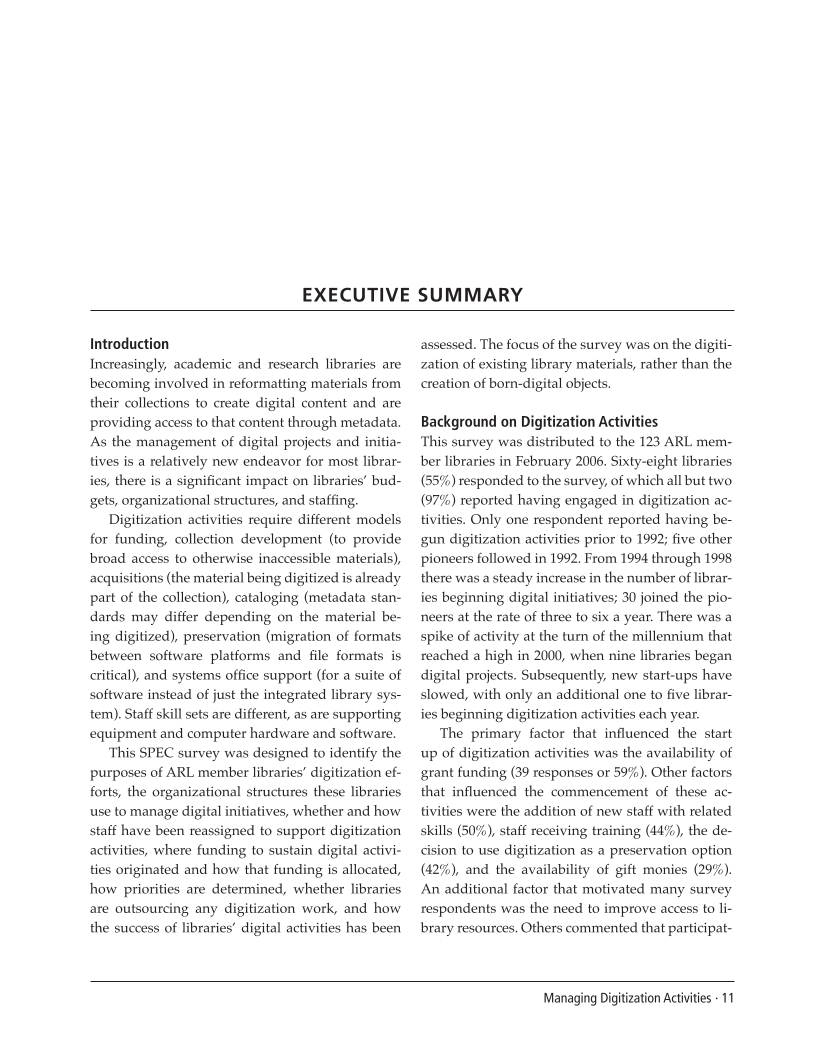Managing Digitization Activities · 11
Executive Summary
Introduction
Increasingly, academic and research libraries are
becoming involved in reformatting materials from
their collections to create digital content and are
providing access to that content through metadata.
As the management of digital projects and initia-
tives is a relatively new endeavor for most librar-
ies, there is a significant impact on libraries’ bud-
gets, organizational structures, and staffing.
Digitization activities require different models
for funding, collection development (to provide
broad access to otherwise inaccessible materials),
acquisitions (the material being digitized is already
part of the collection), cataloging (metadata stan-
dards may differ depending on the material be-
ing digitized), preservation (migration of formats
between software platforms and file formats is
critical), and systems office support (for a suite of
software instead of just the integrated library sys-
tem). Staff skill sets are different, as are supporting
equipment and computer hardware and software.
This SPEC survey was designed to identify the
purposes of ARL member libraries’ digitization ef-
forts, the organizational structures these libraries
use to manage digital initiatives, whether and how
staff have been reassigned to support digitization
activities, where funding to sustain digital activi-
ties originated and how that funding is allocated,
how priorities are determined, whether libraries
are outsourcing any digitization work, and how
the success of libraries’ digital activities has been
assessed. The focus of the survey was on the digiti-
zation of existing library materials, rather than the
creation of born-digital objects.
Background on Digitization Activities
This survey was distributed to the 123 ARL mem-
ber libraries in February 2006. Sixty-eight libraries
(55%) responded to the survey, of which all but two
(97%) reported having engaged in digitization ac-
tivities. Only one respondent reported having be-
gun digitization activities prior to 1992 five other
pioneers followed in 1992. From 1994 through 1998
there was a steady increase in the number of librar-
ies beginning digital initiatives 30 joined the pio-
neers at the rate of three to six a year. There was a
spike of activity at the turn of the millennium that
reached a high in 2000, when nine libraries began
digital projects. Subsequently, new start-ups have
slowed, with only an additional one to five librar-
ies beginning digitization activities each year.
The primary factor that influenced the start
up of digitization activities was the availability of
grant funding (39 responses or 59%). Other factors
that influenced the commencement of these ac-
tivities were the addition of new staff with related
skills (50%), staff receiving training (44%), the de-
cision to use digitization as a preservation option
(42%), and the availability of gift monies (29%).
An additional factor that motivated many survey
respondents was the need to improve access to li-
brary resources. Others commented that participat-
Executive Summary
Introduction
Increasingly, academic and research libraries are
becoming involved in reformatting materials from
their collections to create digital content and are
providing access to that content through metadata.
As the management of digital projects and initia-
tives is a relatively new endeavor for most librar-
ies, there is a significant impact on libraries’ bud-
gets, organizational structures, and staffing.
Digitization activities require different models
for funding, collection development (to provide
broad access to otherwise inaccessible materials),
acquisitions (the material being digitized is already
part of the collection), cataloging (metadata stan-
dards may differ depending on the material be-
ing digitized), preservation (migration of formats
between software platforms and file formats is
critical), and systems office support (for a suite of
software instead of just the integrated library sys-
tem). Staff skill sets are different, as are supporting
equipment and computer hardware and software.
This SPEC survey was designed to identify the
purposes of ARL member libraries’ digitization ef-
forts, the organizational structures these libraries
use to manage digital initiatives, whether and how
staff have been reassigned to support digitization
activities, where funding to sustain digital activi-
ties originated and how that funding is allocated,
how priorities are determined, whether libraries
are outsourcing any digitization work, and how
the success of libraries’ digital activities has been
assessed. The focus of the survey was on the digiti-
zation of existing library materials, rather than the
creation of born-digital objects.
Background on Digitization Activities
This survey was distributed to the 123 ARL mem-
ber libraries in February 2006. Sixty-eight libraries
(55%) responded to the survey, of which all but two
(97%) reported having engaged in digitization ac-
tivities. Only one respondent reported having be-
gun digitization activities prior to 1992 five other
pioneers followed in 1992. From 1994 through 1998
there was a steady increase in the number of librar-
ies beginning digital initiatives 30 joined the pio-
neers at the rate of three to six a year. There was a
spike of activity at the turn of the millennium that
reached a high in 2000, when nine libraries began
digital projects. Subsequently, new start-ups have
slowed, with only an additional one to five librar-
ies beginning digitization activities each year.
The primary factor that influenced the start
up of digitization activities was the availability of
grant funding (39 responses or 59%). Other factors
that influenced the commencement of these ac-
tivities were the addition of new staff with related
skills (50%), staff receiving training (44%), the de-
cision to use digitization as a preservation option
(42%), and the availability of gift monies (29%).
An additional factor that motivated many survey
respondents was the need to improve access to li-
brary resources. Others commented that participat-




































































































































































